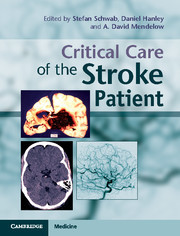Critical Care of the Stroke Patient
Langue : Anglais
Coordonnateurs : Schwab Stefan, Hanley Daniel, Mendelow A. David

Integrates the different therapeutic approaches available in a single volume, suggesting the best therapy option in different clinical situations.
New and groundbreaking therapeutic options for the critical care of patients with cerebrovascular disease have improved patient management, minimized morbidity, reduced in-patient care, improved quality of life, and had a positive economic impact on health service provision. This volume integrates these approaches and suggests the best therapy option for all cerebrovascular conditions. The early chapters of the book focus on monitoring techniques and interventions. Subsequent sections address the critical care of a wide range of cerebrovascular diseases: ischemic stroke, intracranial hemorrhage, subarachnoid hemorrhage, arteriovenous malformations, cerebral venous thrombosis and traumatic injury. The editors and authors are internationally recognized experts in their field, and the text is supplemented by tables and illustrations to demonstrate important clinical findings. This book will meet the needs of stroke physicians, neurologists, neurosurgeons, neurointensivists and interventional neuroradiologists seeking to maximize positive outcomes for their patients.
Part I. Monitoring Techniques: 1. Intracranial pressure monitoring in cerebrovascular disease; 2. Cerebral blood flow; 3. Brain tissue oxygen monitoring in cerebrovascular diseases; 4. Cerebral microdialysis in cerebrovascular disease; 5. Ultrasound and other noninvasive techniques used in monitoring cerebrovascular disease; 6. Scales in the neurointensive care unit; Part II. Interventions: 7. Antiedema therapy in cerebrovascular disease; 8. Decompressive surgery in cerebrovascular disease; 9A. Neuroradiologic intervention in cerebrovascular disease; 9B. Neuroradiologic interventions in cerebrovascular disease: intracranial revascularization; 10. The use of hypothermia in cerebrovascular disease; 11. External ventricular drainage in hemorrhagic stroke; 12. Management of lumbar drains in cerebrovascular disease; Part III. Critical Care of Ischemic Stroke: 13. Intravenous and intraarterial thrombolysis for acute ischemic stroke; 14. Decompressive surgery and hypothermia; 15. Space-occupying hemispheric infarction: clinical course, prediction, and prognosis; 16. Critical care of basilar artery occlusion; 17. Critical care of cerebellar stroke; 18. Rare specific causes of stroke; 19. Blood pressure management in acute ischemic stroke; Part IV. Critical Care of Intracranial Hemorrhage: 20. Management of intracranial hemorrhage: early expansion and second bleeds; 21A. Management of acute hypertensive response in the ICH patient; 21B. Respiratory care of the ICH patient; 21C. Nutrition in the ICH patient; 21D. Management of infections in the ICH patient; 21E. Management of cerebral edema in the ICH patient; 22A. Surgery for spontaneous intracerebral hemorrhage; 22B. Minimally invasive treatment options for spontaneous intracerebral hemorrhage; 22C. Image-guided endoscopic evacuation of spontaneous intracerebral hemorrhage; 23. Intraventricular hemorrhage; 24. Interventions for cerebellar hemorrhage; 25. Interventions for brainstem hemorrhage; Part V. Critical Care of Arteriovenous Malformations: 26. Surgery for arteriovenous malformations; 27. Radiation therapy for arteriovenous malformations; 28. Management of cavernous angiomas of the brain; Part VI. Critical Care of Subarachnoid Hemorrhage: 29. Medical interventions for subarachnoid hemorrhage; 30. Craniotomy for treatment of aneurysms; 31. Endovascular interventions for subarachnoid hemorrhage; 32. Management of vasospasm in subarachnoid hemorrhage; 33. Management of metabolic derangements in subarachnoid hemorrhage; 34. Management of cardiopulmonary dysfunction in subarachnoid hemorrhage; Part VII. Critical Care of Cerebral Venous Thrombosis: 35. Identification, differential diagnosis and therapy for cerebral venous thrombosis; Part VIII. Vascular Disease Syndromes Associated with Traumatic Brain Injury: 36. Ischemic brain damage in traumatic brain injury (TBI): extradural, subdural, and intracerebral hematomas and cerebral contusions; Index.
Stefan Schwab is Professor and Director of the Department of Neurology at the University of Erlangen-Nuremberg, Erlangen, Germany.
Daniel Hanley is Jeffrey and Harriet Legum Professor and Director, Division of Brain Injury Outcomes, The Johns Hopkins Medical Institutions, Baltimore, USA.
A. David Mendelow is Professor of Neurosurgery, University of Newcastle upon Tyne, and Head of Department of Neurosurgery, Newcastle General Hospital, Newcastle upon Tyne.
Daniel Hanley is Jeffrey and Harriet Legum Professor and Director, Division of Brain Injury Outcomes, The Johns Hopkins Medical Institutions, Baltimore, USA.
A. David Mendelow is Professor of Neurosurgery, University of Newcastle upon Tyne, and Head of Department of Neurosurgery, Newcastle General Hospital, Newcastle upon Tyne.
Date de parution : 06-2014
Ouvrage de 564 p.
19.3x25.2 cm
Thème de Critical Care of the Stroke Patient :
© 2024 LAVOISIER S.A.S.



